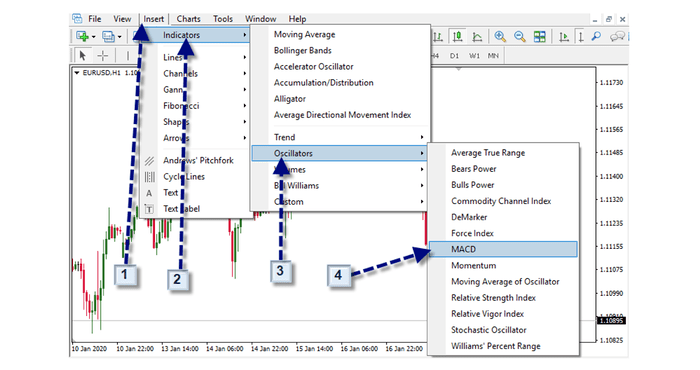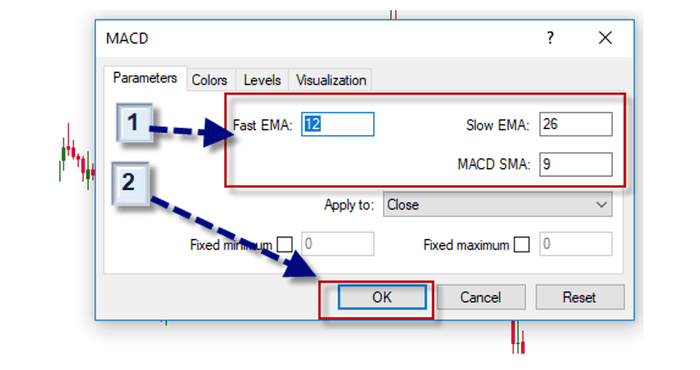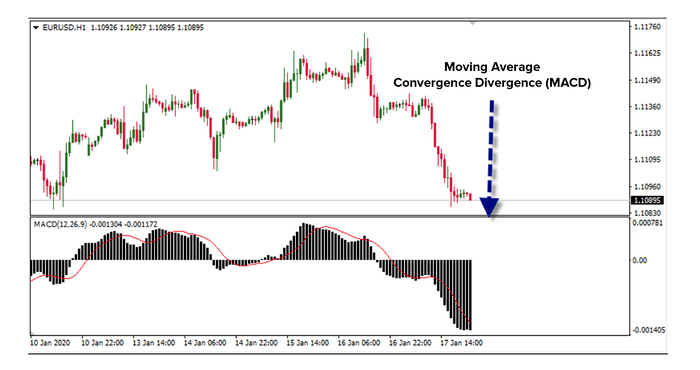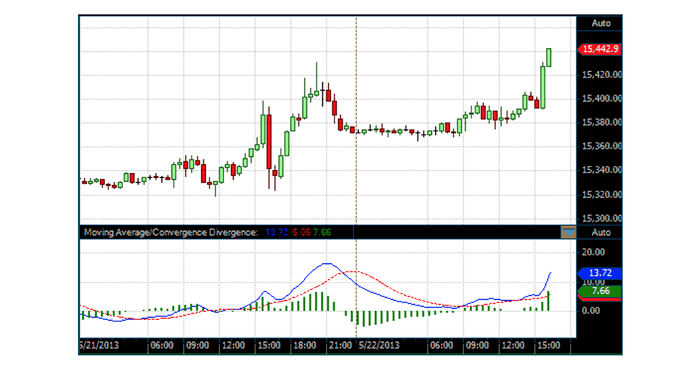Chapter 4 - Introduction to technical indicators
Lesson 4.4 - Moving Average Convergence Divergence (MACD)

The Moving Average Convergence Divergence (MACD) is a simple trend and oscillating momentum indicator developed by Gerald Appel. It shows the convergence and divergence between the exponential moving averages (EMAs) by calculating the difference between the EMAs.
A signal line, which is the EMA from the MACD, is added to indicate bullish and bearish conditions. Due to its construction, the Moving Average Convergence Divergence (MACD) is a trend indicator as it uses moving averages indicating the trend and a very effective momentum indicator.
However, the Moving Average Convergence Divergence (MACD) indicator can be drawn as two lines that fluctuate above and below the zero line, or as a MACD graph indicating the distance between the MACD and the signal line. When drawn as a line, the Moving Average Convergence Divergence (MACD) has no upper or lower limits, and therefore, it does not indicate overbought or oversold conditions.
How is the MACD indicator added to the chart in the MetaTrader 4 platform?
If the interface of the platform is in English, you need to follow these steps:

1- Click on the “insert” tab .
2- Click on the indicators
3- Click on the word “oscillators”
4- Press the word “MACD”
After clicking on the word “MACD” and choosing the desired indicator, the following interface will appear to us:

1- The indicator settings are adjusted according to the technical analyst desire, or the default settings are kept.
2- Click “Ok” after choosing the required MACD settings.
The following chart shows the general appearance of the Moving Average Convergence Divergence (MACD) with default settings, as it appears on the MetaTrader 4 platform.

The previous chart shows the Moving Average Convergence Divergence (MACD) in the lower chart board on the 60-minute chart for EUR\ USD. The red line is the signal line.
How are the Moving Average Convergence Divergence (MACD) measurements calculated?
The Moving Average Convergence Divergence (MACD) indicator uses standard 12-day EMA and 26- day EMA “day or candle” for the closing price with shorter period, rolling EMA faster than longer period and slower EMA. A 9-day EMA is calculated for the difference between two EMAs and is used as a signal line to identify bullish or bearish turning points.
MACD-Histogram represents the difference between MACD (i.e. between EMAs) and signal line (i.e. 9-day EMA from MACD). The graph is positive (i.e. above the zero line) when the MACD is above the signal line and negative when the MACD is below the signal line.
How is the MACD indicator used?
The Moving Average Convergence Divergence (MACD) indicator shows the convergence and divergence of two EMAs. A positive MACD value indicates that the EMA with the shortest and fastest movement is higher than the longer EMA period. This is an indication of a bullish market. When positive values increase, they indicate an increase in momentum towards an up trend; when positive values decrease, this indicates that an up trend is in the phase of losing momentum.
The negative MACD value indicates that the EMA with the shortest and fastest movement is less than the longer EMA period. This is an indication of a bearish market. When negative values increase, they indicate an increase in momentum towards the downside; when negative values decrease, this indicates that a down trend loses momentum to the "impulsive movement".
The intersection of the signal line indicates a turning point in the MACD, where the bullish cross occurs when the MACD line crosses above the signal line, and a bearish cross occurs when the MACD line crosses down above the signal line. These transitions usually indicate a trend reversal.
However, the crossover should be cautiously handled when the Moving Average Convergence Divergence (MACD) indicator is too high or too low, as the MACD also indicates high momentum in these areas, indicating a continuation of the trend rather than a reversal.
The mid-line crossing (or zero-cross line) represents another MACD signal. When the MACD crosses the midline, it becomes positive, indicating that the EMA has a shorter period of time over a longer period. This indicates that the trend has turned bullish. When the MACD MACD crosses the midline, it becomes negative. This indicates that the shortest EMA period crossed over a longer period. This indicates that the trend has turned bearish.
Divergence: The Moving Average Convergence Divergence (MACD) also indicates the difference, or the so-called divergence when the peak of the MACD or MACD valleys does not confirm the peak or valley in the underlying price movement of the security. An ascending divergence occurs when the price of the underlying security is low, while the MACD indicator marks a lower higher price. This indicates that the down trend is losing its momentum, and a possible bullish reversal is possible. A bearish divergence occurs when the price of the underlying security rises higher while the MACD indicator is rising low. This indicates that the bullish trend is losing its momentum, and a possible bearish price reversal.
An illustrative example of the Moving Average Convergence Divergence (MACD) valleys chart is demonstrated in the following figure.

The previous chart displays the Moving Average Convergence Divergence (MACD) with default settings 12,26,9 in the bottom graph board on the 30-minute chart from the Dow Jones Industrial Average. The blue line is the MACD line, and the red line is the signal line. A green graph that shows the difference between the MACD line and the signal line.


 English
English





